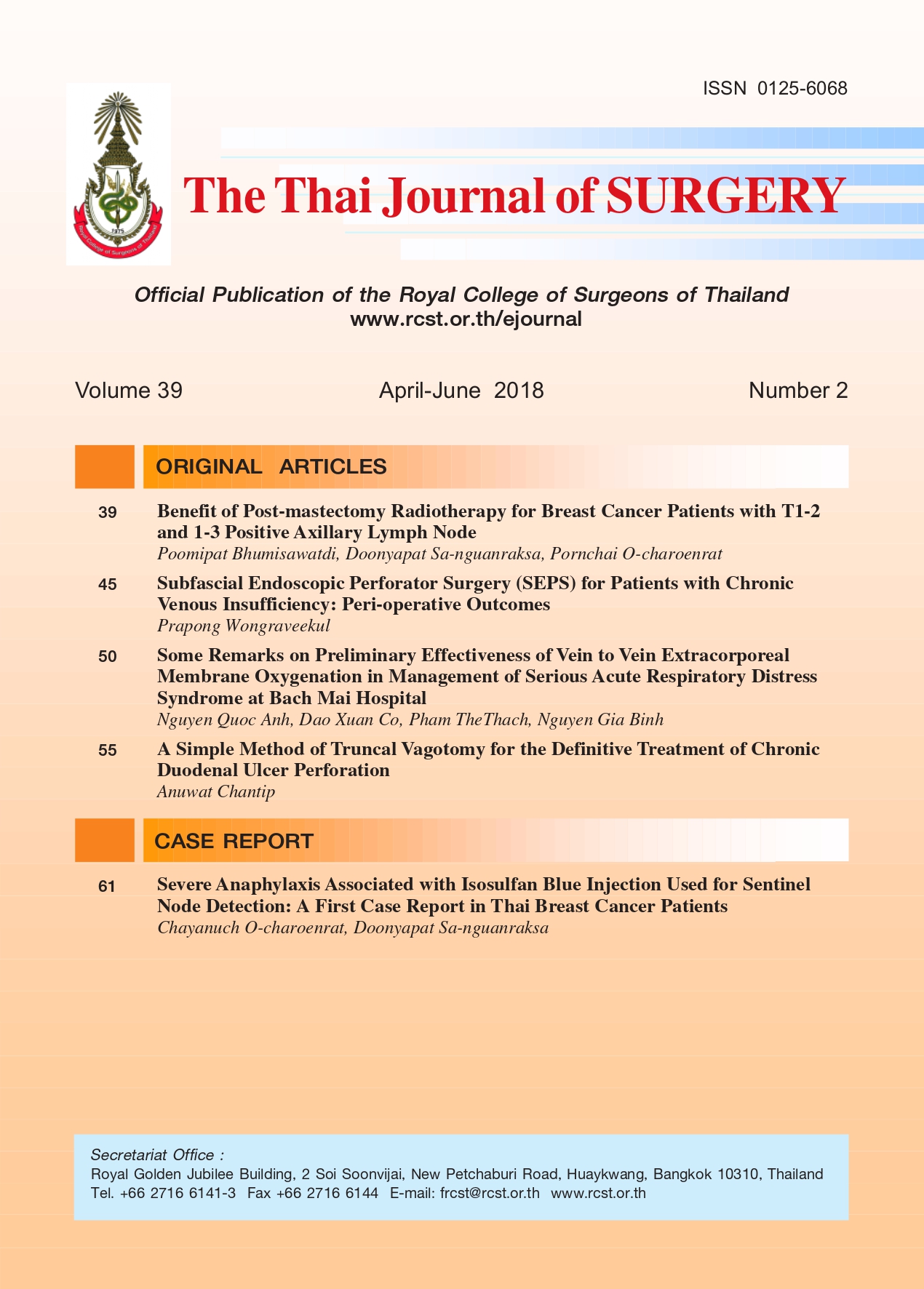Benefit of Post-mastectomy Radiotherapy for Breast Cancer Patients with T1-2 and 1-3 Positive Axillary Lymph Node
Abstract
Background: Post-mastectomy irradiation is suggested in T1-2 and 1-3 positive axillary nodes. In Thailand, there is no consensus of radiotherapy in this group of patients.
Patients and Methods: Medical records of breast cancer patients with T1-T2, 1-3 axillary nodal metastasis and underwent modified radical mastectomy or total mastectomy with positive sentinel node biopsy were reviewed. Disease free survival (DFS) and overall survival (OS) were compared.
Results: There were 66 patients received radiotherapy and 92 patients did not receive radiotherapy. Survival analysis revealed that there was no significant difference in DFS and OS between the two groups. Subgroup analysis showed that radiotherapy in hormone receptor negative patients tended to result in better DFS.
Conclusion: The benefit of radiotherapy in T1-2 with 1-3 positive axillary nodes is not clear, however, selection of the patient to receive radiotherapy might result in better survival.
References
2. Staunton MD, Melville DM, Monterrosa A, Thomas JM. A 25-year prospective study of modified radical mastectomy (Patey) in 193 patients. J R Soc Med 1993;86:381-4.
3. Hellman S. Stopping metastases at their source. N Engl J Med 1997;337:996-7.
4. Overgaard M, Hansen PS, Overgaard J, Rose C, Andersson M, Bach F, et al. Postoperative radiotherapy in high-risk premenopausal women with breast cancer who receive adjuvant chemotherapy. Danish Breast Cancer Cooperative Group 82b Trial. N Engl J Med 1997;337:949-55.
5. Overgaard M, Jensen MB, Overgaard J, Hansen PS, Rose C, Andersson M, et al. Postoperative radiotherapy in high-risk postmenopausal breast-cancer patients given adjuvant tamoxifen: Danish Breast Cancer Cooperative Group DBCG 82c randomised trial. Lancet 1999;353:1641-8.
6. Recht A, Edge SB, Solin LJ, Robinson DS, Estabrook A, Fine RE, et al. Postmastectomy radiotherapy: clinical practice guidelines of the American Society of Clinical Oncology. J Clin Oncol 2001;19:1539-69.
7. Ragaz J, Olivotto IA, Spinelli JJ, Phillips N, Jackson SM, Wilson KS, et al. Locoregional radiation therapy in patients with high-risk breast cancer receiving adjuvant chemotherapy: 20-year results of the British Columbia randomized trial. J Natl Cancer Inst 2005;97:116-26.
8. Ebctcg, McGale P, Taylor C, Correa C, Cutter D, Duane F, et al. Effect of radiotherapy after mastectomy and axillary surgery on 10-year recurrence and 20-year breast cancer mortality: meta-analysis of individual patient data for 8135 women in 22 randomised trials. Lancet 2014;383:2127-35.
9. Mamtani A, Patil S, Stempel M, Morrow M. Axillary Micrometastases and isolated tumor cells are not an indication for post-mastectomy radiotherapy in stage 1 and 2 breast cancer. Ann Surg Oncol 2017;24:2182-8.
10. Overgaard M, Nielsen HM, Overgaard J. Is the benefit of postmastectomy irradiation limited to patients with four or more positive nodes, as recommended in international consensus reports? A subgroup analysis of the DBCG 82 b&c randomized trials. Radiother Oncol 2007;82:247-53.
Downloads
Published
How to Cite
Issue
Section
License
Articles must be contributed solely to The Thai Journal of Surgery and when published become the property of the Royal College of Surgeons of Thailand. The Royal College of Surgeons of Thailand reserves copyright on all published materials and such materials may not be reproduced in any form without the written permission.


